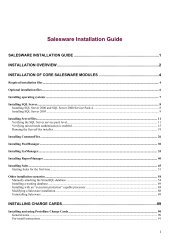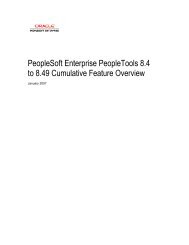Cognos ReportNetTM Installation and Configuration Guide
Cognos ReportNetTM Installation and Configuration Guide
Cognos ReportNetTM Installation and Configuration Guide
You also want an ePaper? Increase the reach of your titles
YUMPU automatically turns print PDFs into web optimized ePapers that Google loves.
Chapter 4: Configuring ReportNet<br />
Ensure that you configured ReportNet to use a <strong>Cognos</strong> Series 7 namespace as an<br />
authentication provider (p. 42).<br />
Steps for ReportNet<br />
1. On the computer where Content Manager is installed, start <strong>Cognos</strong> <strong>Configuration</strong>.<br />
2. In the Explorer window, under Security, Authentication, click the <strong>Cognos</strong> Series 7<br />
namespace.<br />
3. In the Properties window, under Cookie settings, ensure that the Path, Domain <strong>and</strong><br />
Secure flag enabled properties match the settings configured for <strong>Cognos</strong> Series 7.<br />
Steps for <strong>Cognos</strong> Series 7<br />
1. Start <strong>Configuration</strong> Manager.<br />
2. Click Open the current configuration.<br />
3. On the Components tab, in the Explorer window, exp<strong>and</strong> Services, Access Manager -<br />
Runtime <strong>and</strong> click Cookie Settings.<br />
4. In the Properties window, ensure that the Path, Domain <strong>and</strong> Secure Flag Enabled<br />
properties match the settings configured for ReportNet.<br />
Configure Cryptographic Settings<br />
ReportNet requires a cryptographic provider; otherwise it will not run.<br />
You can configure cryptographic <strong>and</strong> cryptographic provider settings, including the following:<br />
• advanced algorithms<br />
These include signing, digest, <strong>and</strong> confidentiality algorithms.<br />
• common symmetric key store (CSK) properties<br />
The CSK is used by ReportNet components to encrypt <strong>and</strong> decrypt data.<br />
• signing key store properties<br />
The signing key pair includes the private key used to generate the digital signature <strong>and</strong> the<br />
public key used to verify authenticity.<br />
• encryption key store properties<br />
The encryption key pair includes the private key used to encrypt data <strong>and</strong> the public key<br />
used to decrypt data.<br />
ReportNet requires a cryptographic provider. By default, the cryptographic provider for<br />
ReportNet uses keys up to 40 bits in length for data encryption <strong>and</strong> secure sockets layer (SSL)<br />
protocol. You can configure other cryptographic providers which use key sizes greater than 40<br />
bits, such as the Enhanced Encryption Module for OpenSSL or the Enhanced Encryption<br />
Module for Entrust, available from <strong>Cognos</strong>. For more information, see the Enhanced Encryption<br />
Module for OpenSSL <strong>Installation</strong> <strong>and</strong> <strong>Configuration</strong> <strong>Guide</strong> or the Enhanced Encryption Module<br />
for Entrust <strong>Installation</strong> <strong>and</strong> <strong>Configuration</strong> <strong>Guide</strong>.<br />
Steps for Cryptographic Settings<br />
1. Start <strong>Cognos</strong> <strong>Configuration</strong>.<br />
2. In the Explorer window, under Security, click Cryptography.<br />
46 <strong>Cognos</strong> ReportNet TM
















